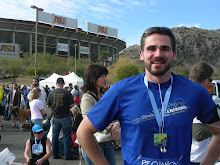SPRING MEANS WELCOMING BASEBALL, SAYING FAREWELL TO WOEFUL BRACKETS
Before I begin this long-overdue post, could we please have a moment of silence for the absolute worst bracket I've ever filled out?
.
.
.
.
.
.
.
.
.
.
.
.
.
Thank you.
Seriously, zero teams in the Final Four? Ohio State getting manhandled by Georgetown? Bradley knocking off Pitt? And, most poignantly, George Mason knocking off one of my elite 8 teams in the first round, and my national runner-up in the fourth round? What can I say but the madness has been truly mad. Like almost everyone outside of Gainesville, Fla., I, too, will be rooting for the "Kryptonite Kids" from Fairfax, Va., this weekend. My wounded ego might prohibit me from making as many predictions from now on, so instead, I'll just try to stick to analysis and insights.
Major League Baseball, which slowly but surely is trying to put aside the steroid scandal and overcome the letdown of the World Baseball Classic, gets underway officially with the Tribe playing at the White Sox Sunday night. It's the second time in recent memory the Indians have played the first game (they opened the 2002 season, too.) I know this upsets Reds fans who feel that "baseball started in Cincinnati, and that's where it should start every year!" I'm a sucker for tradition, too, but I can't help but be excited to see the Tribe on national TV taking on the world champs and division rivals.
Quite frankly, if the Indians want to make their 90+ wins count this year--meaning get them into the playoffs--they'll need to get a few more victories against the south siders. With the number of times these two teams will play each other, Indians hitters will have to figure out Buerhle and Contreras and win some ballgames.
No doubt part of the reason the Indians offense was inconsistent last year was that both Chicago and Minnesota have great pitching, and the Tribe saw them seemingly every week. Notice how the Indians beat up on the weak pitching from the NL West? Winning baseball games is contingent on strong pitching. The bad news is the Indians will see plenty of that again this year. The good news is they will have good pitching of their own, though it might be in a different form.
Millwood's gone. Elarton's gone. Byrd and Johnson are new. I consider these transactions a push, and I'm not concerned with the loss of Millwood. Though I don't know what the Indians will get from Johnson, I expect good things out of Sabathia, Lee, Westbrook and Byrd (a nice veteran pickup.) If Johnson falters, Carmona--who I think should have gotten the fifth starting job anyway--is waiting in the wings, and trust me, that guy can get people out.
The bullpen has a new look, and we should expect this every year from Shapiro. Though Wickman is back, Mota and Graves are in to replace Howry and Rhodes. It's hard to say whether the staff got worse or better. Wickman saved 45 games last year, so I won't join the "Wickman must go" club yet. He's earned the right to have another chance. Plus, Cabrera, Mota, and Graves are all insurance policies if he struggles. As long as the Indians are consistently ahead after the 7th inning, I feel confident they're going to win a lot of games. Their problem last year, at least to the White Sox, was being down by one run and never being able to make it up.
The big question mark: For me, it's still offensive production. I'm not worried about Sizemore, Hafner, Martinez, Peralta or Belliard. I'd like to think that Casey Blake is better than what he showed last year. But what about Boone, Broussard, Perez and the new left-fielder Jason Michaels? If you're a faithful reader of mine, you know I wasn't happy about the Indians' replacing of Crisp with Michaels. Though Michaels has had a decent spring, and Wedge has called him "a great #2 hitter," I am not sure how well he'll do at the top of the order. My suspicion is that he'll hit when Sizemore hits, but he'll struggle when Sizemore doesn't. Last year the Indians really had two leadoff hitters hitting back-to-back. That isn't the case this year. I'll avoid passing too much judgment on him, but I won't be surprised if he gets dropped in the order and either Belliard or Boone winds up hitting second.
We all know that this is Ben Broussard's last chance. Honestly, I do like him, but he just did not hit last year when it really mattered. Garko and Marte will both push him. We'll see how he responds.
The reality is expectations are high, not just from Cleveland, either. The Indians are a dark-horse pick to win it all. I'm not even going to venture a prediction on the number of wins, whether or not they make the playoffs and certainly not if they will advance in the playoffs. But I will say this: Grady Sizemore and Jhonny Peralta playing under long-term contracts (as well as the rest of the "core') means fun Indians baseball to watch for the next several seasons. I can't wait.
Labels: Baseball, Basketball, Cleveland Indians, College Basketball

